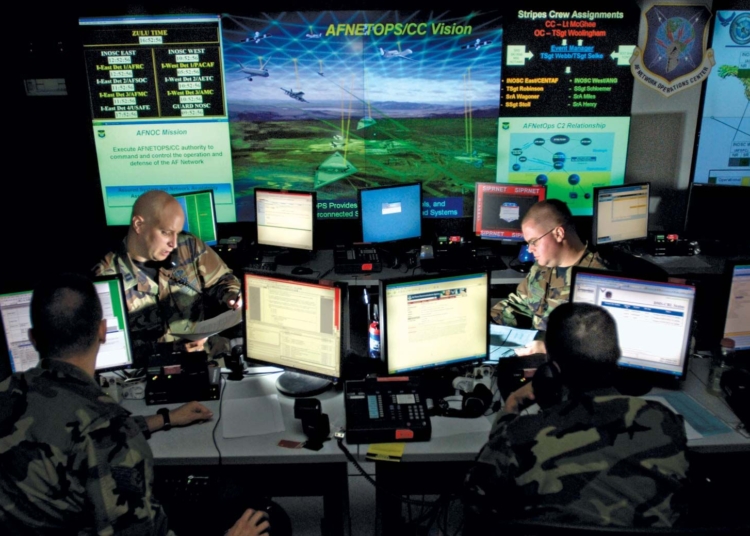This content discusses the emergence of advanced cybersecurity in the military. With the increasing reliance on digital technology and interconnected systems, nations are recognizing the need to develop strategies and technologies to protect themselves from cyber threats. The article highlights the growing threat of cyber attacks and the importance of advanced cybersecurity measures. It explores various strategies employed in military cybersecurity, such as threat intelligence and network segmentation, as well as technologies like intrusion detection systems and encryption. International collaboration is also emphasized as crucial in combating cyber threats. The article concludes by discussing the future of military cybersecurity and the need for continued investment in research and development.
Cyber Warfare: The Emergence of Advanced Cybersecurity in the Military
Introduction
Cyber warfare has become an increasingly significant domain in modern warfare. With the growing reliance on digital technology and the interconnectedness of various systems, nations are recognizing the importance of developing advanced cybersecurity measures to protect themselves from cyber threats. This article explores the emergence of advanced cybersecurity in the military, focusing on the strategies and technologies employed to counter cyber attacks.
The Growing Threat of Cyber Attacks
In recent years, cyber attacks have become more frequent and sophisticated, posing a significant threat to both civilian and military infrastructure. Nation-states and non-state actors are constantly seeking to exploit vulnerabilities in computer networks, aiming to gather sensitive information, disrupt critical systems, or cause chaos. Recognizing the potential impact of cyber warfare, military forces across the globe are investing heavily in cybersecurity measures to mitigate these threats.
Understanding Advanced Cybersecurity
Advanced cybersecurity in the military incorporates a wide range of strategies and technologies to protect military networks and systems. These measures encompass prevention, detection, response, and recovery to ensure the resilience of military infrastructure in the face of cyber threats. It involves a multi-layered approach that combines cutting-edge technologies, well-informed personnel, and effective policies.
Strategies Employed in Military Cybersecurity
1. Threat Intelligence: Military forces gather intelligence on potential adversaries and emerging cyber threats to proactively identify vulnerabilities and develop countermeasures.
2. Network Segmentation: Military networks are divided into smaller segments, limiting the spread of a potential cyber attack and minimizing its impact on critical systems.
3. Multi-Factor Authentication: Strong authentication protocols, such as biometrics or smart cards, are implemented to prevent unauthorized access to military systems.
4. Vulnerability Assessments: Regular assessments are conducted to identify vulnerabilities in military networks and address them before they can be exploited.
5. Incident Response Teams: Specialized teams are trained to respond swiftly and effectively to cyber incidents, minimizing the damage caused by an attack and restoring operations quickly.
Technologies in Military Cybersecurity
1. Intrusion Detection Systems (IDS): IDS monitors network traffic, identifying and flagging any suspicious activity that could indicate a cyber attack in progress.
2. Firewalls: Firewalls act as a barrier between the military network and external threats, filtering out malicious traffic and unauthorized access attempts.
3. Encryption: Military communications and data storage are often encrypted to protect against eavesdropping and unauthorized access.
4. Machine Learning: Artificial intelligence and machine learning algorithms are employed to detect new and evolving cyber threats by analyzing patterns and anomalies in network behavior.
5. Secure Communications: Secure communication protocols, such as Virtual Private Networks (VPNs), are used to ensure the confidentiality and integrity of sensitive military information.
The Importance of International Collaboration
Cyber threats are not limited by borders, making international collaboration crucial in the realm of cybersecurity. Military forces around the world are increasingly working together to share information, intelligence, and best practices to combat cyber attacks effectively. Collaborative efforts often involve joint training exercises, knowledge sharing platforms, and the establishment of international cybersecurity standards.
The Future of Military Cybersecurity
The emergence of advanced cybersecurity in the military is an ongoing process, as cyber threats continue to evolve and adapt. Moving forward, military forces will need to stay ahead of cyber adversaries by investing in research and development to create innovative cybersecurity solutions. This includes the utilization of emerging technologies like Artificial Intelligence (AI) and quantum computing in the field of cybersecurity.
Conclusion
Cyber warfare has become a critical domain in modern warfare, with cyber attacks posing a significant threat to military infrastructure. The emergence of advanced cybersecurity in the military showcases the importance of protecting military networks and systems from cyber threats. Through the implementation of strategies and technologies such as threat intelligence, network segmentation, and machine learning, military forces aim to ensure the resilience of their infrastructure in the face of evolving cyber threats. International collaboration plays a vital role in mitigating these threats, and continued investment in research and development will be crucial to stay one step ahead of adversaries. The future of military cybersecurity will undoubtedly continue to evolve with the rapid advancements in technology and the ever-changing nature of cyber threats.












